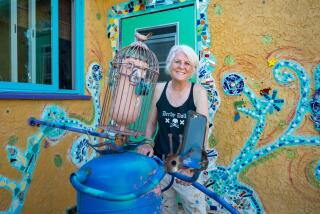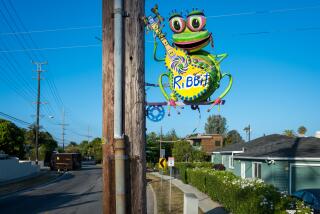Artist pays homage to L.A.’s unseen workers
Their faces are vague, the color of coffee beans, but before Ramiro Gomez heads out with pliers and wire to install them, he gives each one a name.
There was Guillermina, named for his Aunt Guille, a housekeeper at a casino hotel; Maria Elena, after his mom, a janitor at an elementary school; and Luis, like Uncle Luis, who delivers meat for a carniceria.
For the last eight months, Gomez, an artist from West Hollywood, has made the invisible visible by installing life-size cardboard cutouts of nannies, gardeners, valet workers and housekeepers in Beverly Hills, the Hollywood Hills and other wealthy areas.
His acrylic paintings appear unexpectedly around the Westside, like pop-ups from a children’s book. Gomez puts them on display to raise provocative questions.
“We see the beautiful homes. The hedges are trimmed, the gardens are perfect, the children are cared for,” Gomez said. “We’ve come to expect it to be this way. But who maintains all this? Who looks after it? And do we treat the workers with the dignity they deserve? Do we stop and notice them?”
Often, people zoom right by Gomez’s cardboard creations. So he puts them in places that get plenty of foot traffic — busy intersections, parking lots and parks.
Recently, the 25-year-old tried his luck outside the Beverly Hills Hotel.
He propped a housekeeper named Ana against a hedge near the entrance. She stood facing forward, clutching her purse with both hands. Within a day she had been removed by hotel staff.
When President Obama came to town for a fundraiser at George Clooney’s home in Studio City, Gomez installed four gardeners wielding a giant water hose a few blocks away. He was soon ordered to remove them by the Secret Service.
Most pieces last a day or two if Gomez is lucky. Once, a valet parker he planted outside a lot near the Sunset Strip made it four days.
Gomez writes his contact information on the back of each piece so people can tell him where the art ended up. So far, no one has reached out.
At first it was tough to let go. He’d stand by for a while to see people’s reactions, then take the cutout down and lug it back home.
But then Gomez realized it was not his place to keep public art out of view.
So he learned to walk away.
These days he goes to a Best Buy store every Monday in search of cardboard. He sifts through the dumpster for TV boxes. The 70-inchers allow his laborers to stand at least 5 feet tall.
He hauls the boxes home to the two-bedroom apartment he shares with his partner of six years, a film editor whose latest project is “Beverly Hills Chihuahua Part 3.”
In a bedroom that doubles as a studio, his Juanitas, Adolfos and Candelarios quietly come to life.
The idea for his project came a few years back, after he dropped out of art school.
He needed money so he took a job as a nanny, caring for a 9-year-old and 8-month-old twins in the Hollywood Hills. He worked in a home with sweeping views of the hills along Laurel Canyon. His boss kept plenty of home decor magazines around, which later came in handy.
Gomez got to know the workers in the neighborhood. He followed the same routine as the nannies: play time, lunch, nap, a trip to the park, then dinner and bath time.
At the park in West Hollywood, the nannies were a tight-knit bunch. Aminata was from Haiti and Lulu from Britain. The rest were Central American and Mexican. They had worked in the hills for years, some for decades.
When they saw Gomez, they didn’t know what to make of him. A male nanny? A gay male nanny?
But Gomez soon fell into their daily talk about favorite soap opera stars, their children’s progress in school, their bus rides and their bosses.
Some of the bosses were nice, some weren’t. The same for the children. Notorious among them was a little girl from Beverly Hills who no one wanted to take care of. The girl’s mother was a Hollywood bigwig, they said, known for her sharp tongue. She often chased away nannies after only a month.
They talked constantly about trying to get better pay and hours.
Soon the decor magazines that had entertained Gomez began to take on another meaning. He saw the posh living rooms, the fancy kitchens and immaculate gardens, but there was no mention of the workers who took care of them.
“They were invisible,” Gomez said. “As if the homes just magically cleaned themselves.”
So he began to insert the workers himself. He cut out the full-page ads of luxurious settings and with fine brush strokes painted in a housekeeper or gardener — brown figures bent over lawn mowers, dust cloths and mops.
He painted dozens of pages, transforming each into a thought-provoking statement.
He wanted to take his message public, splash it on the walls like the muralist Diego Rivera or popular graffiti artist Banksy. But he didn’t want problems with police.
So he turned to cardboard cutouts. The Westside’s pristine mansions and fancy cars provided a perfect backdrop.
He tied the cutouts with aluminum wire to trees, poles and hedges, then announced installation locations on his blog, Happy Hills.
Before long, people began to notice: other bloggers, artists and college students. The family he worked for appreciated his project.
A gallery in Culver City called Koplin Del Rio heard about Gomez and contacted him.
“We looked at him as this wonderful little diamond in the rough,” said gallery co-director Sugar Brown. “Here was this idea just germinating within him and he was exploring it himself, from a new place, not the same rhetoric we’ve heard again and again.”
Academics also took interest.
UCLA began to archive his magazine pieces and photos of his cutouts. (It plans to have an exhibit of his work next spring.) And George Lipsitz, a UC Santa Barbara professor of American Studies, began to mention Gomez in his lectures. He thought the young man’s art offered a unique look at immigrant labor.
“Here are these simple forms, acrylic on cardboard,” he said, “asking us, in a very disarming way, to step back and think about the important work these workers do.”
On the streets, it’s not entirely clear how the public regards the images.
Sometimes people pause. They’ll snap a photo and say things like: What do you think it’s for? I wonder who put it here. Most walk by. They’re in a hurry, don’t get it or don’t care.
Gomez has no idea if his pieces end up on display in people’s homes or at the bottom of dumpsters.
Until now, the only resistance he’s faced has come, surprisingly, from Latinos.
An angry worker confronted him recently at a Beverly Hills intersection. Gomez had just installed a cutout of a vendor selling maps of stars’ homes across the street from a real vendor.
As soon as the man saw the piece, he forced Gomez to take it down. He had enough attention from homeowners, police and the city, he told Gomez. The last thing he needed was a painted doppelganger.
“It was uncomfortable to hear,” Gomez said. “But I learned from it.”
One day, he hopes to see his workers showcased in galleries or perhaps on a mural in Beverly Hills — though he’s well aware that more attention is sure to bring more criticism.
For now, he doesn’t make money from his art, and he continues to care for kids, this time for a different family.
On a recent morning he put the final touches on a piece he’s had in mind for a while: a nanny. He gave her a pink shirt, black pants and a state-of-the-art stroller. He named her Sylvia, after an aunt.
He set out from his apartment with his pliers and twine, excited and nervous. He planned to install Sylvia at West Hollywood Park, where the nannies gather. He didn’t know how they were going to react.
The moment Gomez showed up, the women watched him. He checked the sun, the wind, the visibility, until finally, he found the perfect spot.
Maria Teresa Martinez, a nanny he didn’t know, came over with her charge, a blond, curly-haired boy named Charlie. She took a look, threw her head back and laughed. She was wearing a pink shirt and black pants.
“Will you look at that!” Martinez said.
At 63, the Salvadoran has worked as a nanny for 30 years. She was helping raise Charlie now, and years before, she had helped raised Charlie’s mother. The family was good and she was lucky, she said.
Looking up and down at the cutout, she let out a long sigh.
“This is good,” she said, backing up her stroller to head home. “We have so many stories to tell, so many, we could write a book.”
esmeralda.bermudez@latimes.com
More to Read
Sign up for Essential California
The most important California stories and recommendations in your inbox every morning.
You may occasionally receive promotional content from the Los Angeles Times.











